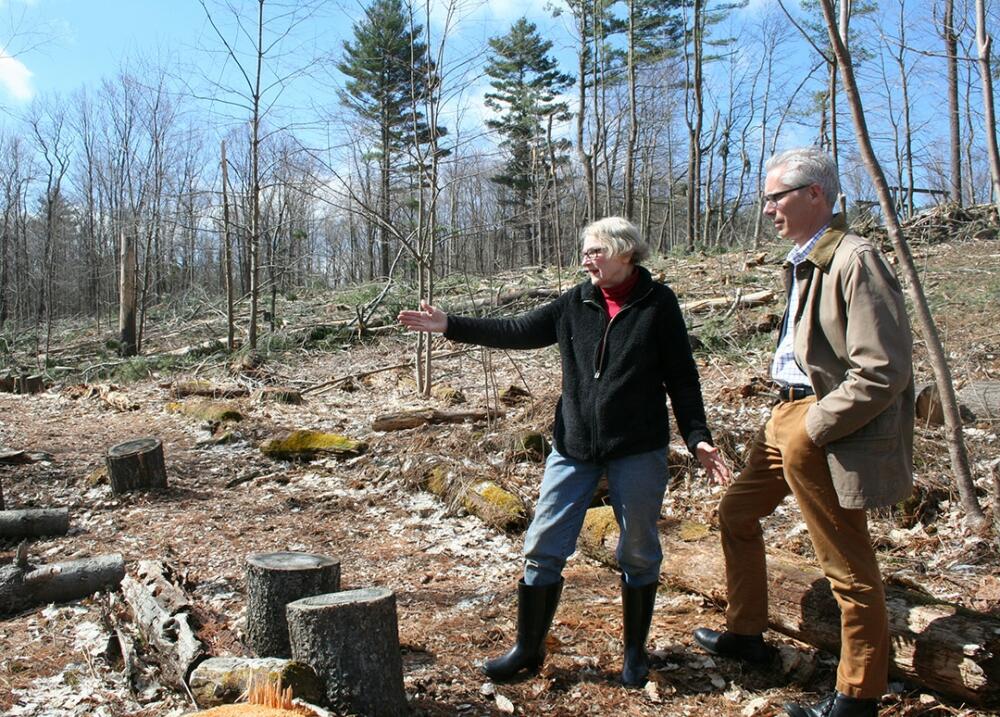For Immediate Release: April 16, 2019
Contact: Susan Strano, Marketing Director
sstrano@benningtonmuseum.org 802-447-1571 ext. 204
Image: Jackie Marro and Bennington Museum Robert Wolterstorff
look over the Hadwen Woods and George Aiken Wildflower Trail
Diseased Pines Come Down
BENNINGTON, VT, April 16, 2019 – The George Aiken Wildflower Trail is an engaging garden covering six acres of Bennington Museum’s 10-acre property. Located in the Hadwen Woods, its goal has been to provide a pleasant retreat for visitors and to showcase many of the native plants, ferns and wildflowers that George Aiken – one of Vermont’s best-known and most-respected political figures – grew at his nursery in Putney and wrote about in his book Pioneering with Wildflowers. While the wildflowers of the area continue to thrive, the Eastern White Pines have been almost universally infected by red rot (Fomes pini), a fungus that penetrates the heart of the trunk, severely weakening it. Every year the Museum has been losing 10-30 trees along the trail. After more than a decade of study, in June 2018 the Museum’s Executive Committee voted reluctantly to remove the pine forest, and begin implementing plans for a new landscape designed by Reed Hilderbrand, one of the foremost firms of landscape architects in the nation.

The problems go back to 2007, when over thirty trees fell. On the advice of a state forester, the Museum removed 270 trees in the hope that the remaining trees would get stronger. However, in 2008 another twenty trees fell, the trunks snapping off approximately twenty feet above the ground. The Museum engaged a state forester for further evaluation. The advice received remained consistent: the pines initially grew too close together and were never thinned out. They were too tall and thin, with sparse branches only at the top. Growing so close together also facilitated the spread of the red rot, which infected almost all the trees. The trees could not be treated and would continue to fall, if we did not remove them first. In December 2012, another 55 trees were felled in a single devastating storm. This created a domino effect: the loss of trees opened up the heart of the woods to the wind, leading to further losses. The losses caused work and expense for the Museum, demoralized the volunteers who have created and maintained the Wildflower Trail, and posed a danger to visitors and to houses on neighboring properties
“Most of the pines were cut in November and December 2018 and cleanup is underway. Already spectacular vistas have been opened up from the top of the hill. Plans are now being developed by Reed Hilderbrand for a natural New England landscape that preserves the George Aiken Wildflower Trail in the context of meadows, a successional forest, a fern walk, and the existing hardwood forest in the bottomlands near the creek.” states Robert Wolterstorff, Executive Director.
The Hadwen Woods was donated to the Bennington Museum by the late George Hadwen, the founder of the Bennington Pennysaver and a former museum trustee. The George Aiken Wildflower Trail has been developed over the last decade entirely by private donations and by a team of volunteers led by Jackie and Tony Marro. The trail is open to the public dawn-to-dusk, free of charge, and is a delightful place to hike, walk your dog, picnic, or sit and relax on one of the artist-designed benches. Anyone interested in doing volunteer work or donating money or plants should contact Jackie Marro at jcminvt@hotmail.com.
About the Museum
Bennington Museum is located at 75 Main Street (Route 9), Bennington, in The Shires of Vermont. The museum is open Thursday through Tuesday, 10 am to 5 pm. and is wheelchair accessible. Regular admission is $10 for adults, $9 for seniors and students over 18. Admission is never charged for younger students, museum members, or to visit the Museum Store. Visit the Museum’s website www.benningtonmuseum.org or call 802-447-1571 for more information.
